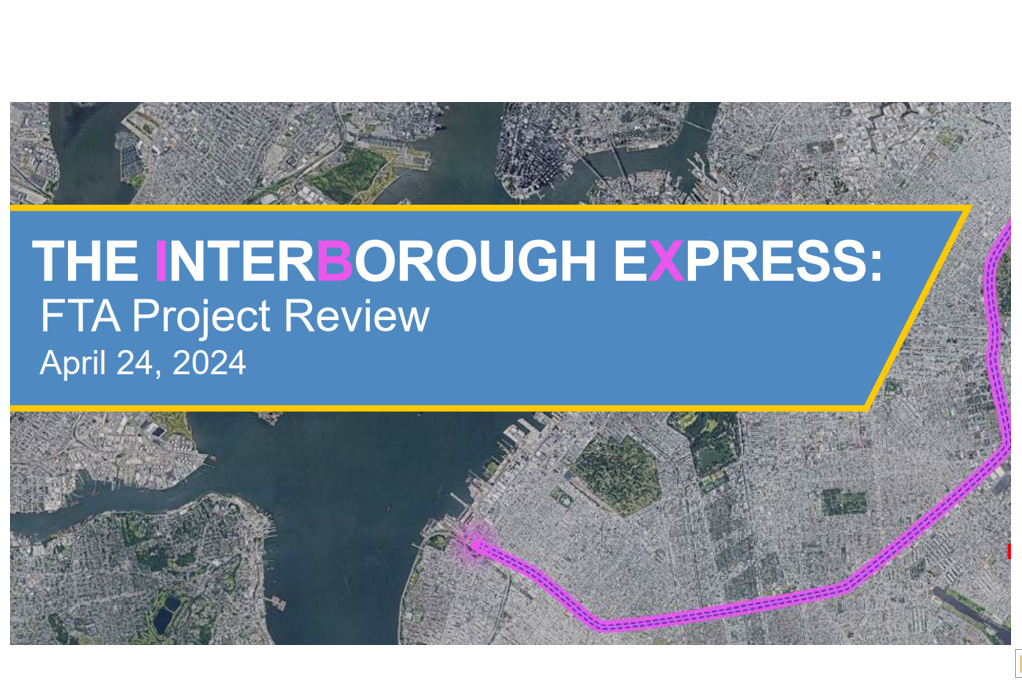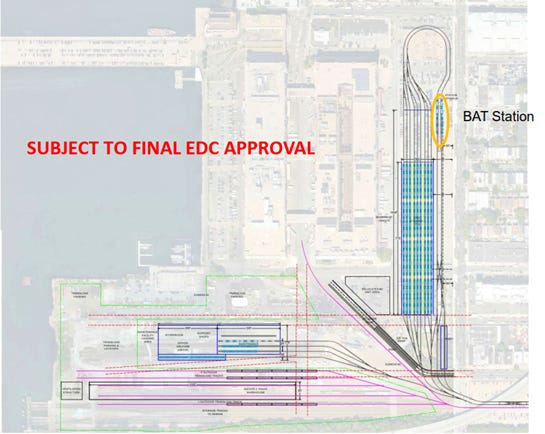This is the another of a series of articles introducing documents obtained from the MTA in response to Freedom of Information Law (FOIL) requests.
I have recently obtained a complete copy of an MTA presentation to the Federal Transit Administration, titled, “Interborough Express, FTA Project Review, April 24, 2024.”
Although the information is over a year old, I note a few points of interest in this document, which is attached.
One interesting aspect of the Interborough Express (IBX) proposal is the plan for use of land adjoining the Brooklyn Army Terminal (BAT) in Bay Ridge Brooklyn. BAT itself is a historic landmark, now occupied by a number of businesses. NYNJ Rail, a subsidiary of the Port Authority of New York and New Jersey, operates a railyard and carfloat to New Jersey just south of BAT and has tracks serving businesses along 1st Avenue on the west side of BAT. The FTA Project Review presentation shows the existing conditions at BAT in the following drawing on slide 5. The BAT buildings are shown in purple.
The final western station on the originally planned IBX line was to be at 4th Avenue, with a yard, and maintenance and storage facility (MSF) adjoining BAT. Now, the MTA has added a BAT station at 2nd Avenue between 59th and 60th Streets, largely due to potential ridership to and from NYU Langone Hospital at 56th Street. According to the April 2024 presentation, the BAT station, yards and cart wash are to be located in place of the existing parking lot east of the BAT buildings, shown in light brown in the drawing above.
In the drawing above of the proposed layout, the IBX tracks and facilities are indicated in blue and the tracks of NYNJ Rail are shown in purple.
Regarding the railcar fleet (see slides 8-10), the focus continues to be on Light Rail Vehicles (LRVs). Some key railcar selection points (quoted from the presentation) were:
· LRV analyses allows us to right-size fleet assumptions, ensure sufficiency of MSF, refine ridership analyses and determine station platform lengths.
· Universe of LRV's were assessed to understand options for IBX fleet.
· Compared acceleration/ deceleration, maximum speed, capacity and length.
· Determined consist requirements to meet ridership demand
· All rolling stock options have similar environmental impacts.
· Accommodate 2050 ridership.
And, most significantly:
· Limit to universe of available North American LRVs.
Fifteen traction power substations were planned, approximately one mile apart. (See slides 11-12). That suggests that low voltage operation (probably ~1200 V or less) is planned, although slides 19 and 21 indicate traction power is to be provided by catenary. That is surprising, because an advantage of catenary over third rail is that a much higher voltage (such as 25,000 V) can be used, in which case only three or four substations would be required. Could this be because some LRV suppliers offer only low voltage power collection?
Another interesting revelation of this presentation is that fewer bridges along the IBX line would need to be rebuilt, as compared with the number projected in the earlier, PEL Report. (See slides 20-24, 26, 35, 39 & 44).
The 4th Avenue Station (actually located closer to 5th Avenue) has been changed to a center platform design to avoid interference with the piers for the Gowanus Expressway, above the station. (See slide 33 and below). A connection with the B63 bus on 5th Avenue is mentioned, but nothing is said about connection to a new station on the R subway line, suggested in other IBX documents. (I question the need for a 4th Avenue IBX station, because most transferring riders will be headed toward downtown Brooklyn and Manhattan, and can change to the N line at 8th Avenue. That transfer should by optimized, preferably as a cross-platform transfer.).
The proposed location for the 8th Avenue IBX station has been moved to the east, to the place shown by the red outline in the drawing below, copied from slide 34. Although the presentation says there will be a connection with the N subway line station at 8th Avenue, the connection is not shown or explained.
Finally, the presentation discloses the location of a portal for the proposed Cross Harbor Freight Program Tunnel, located between 11th and 14th Avenues, as shown below:
Background—Obtaining the FTA Project Review Document
In September 2024, I submitted several Freedom of Information Law (FOIL) requests to the MTA, including one for documents provided by the MTA to the US Department of Transportation (USDOT). While the MTA often asserts FOIL exceptions in an effort to avoid producing documents, some of the principal, potential exceptions do not apply to documents provided to federal agencies. As usual, I encountered serious delays and refusals to produce documents in response to this request. I sought review of the MTA’s refusal to provide the requested documents by a Petition to the NY Supreme Court. The MTA has now partially responded to the request, providing the attached document.
This article expresses the personal views of the author and does not express the views of his employer, or any client or organization. The author has degrees in law and physics, and has taken several engineering courses. After five years of work as an engineer, he has practiced law primarily in the field of patents for over 50 years, dealing with a wide variety of technologies. He is a life-long railfan and user of public transportation in the United States, Europe and Japan.
Because this article is relatively short and lacks detailed notes, no PDF copy is attached.
[1] © John Pegram, 2025.










Thanks, fixed on site now.
I think you may have forgotten to attach the FTA document, unless I'm not seeing where it is.